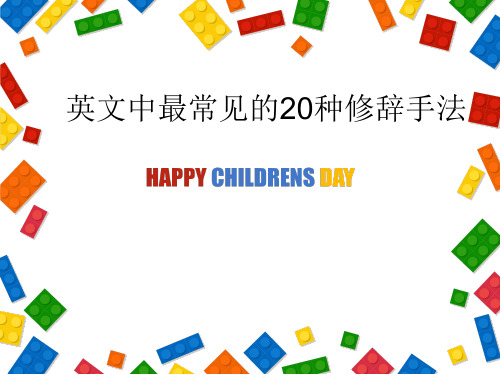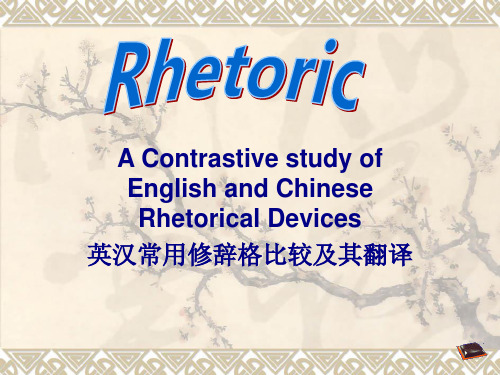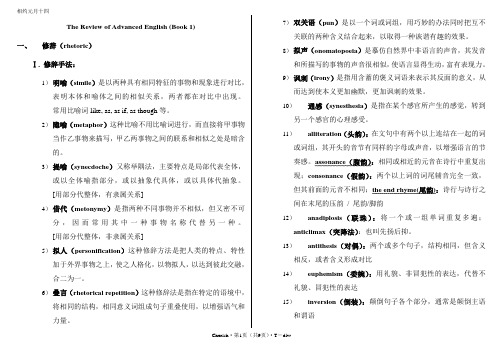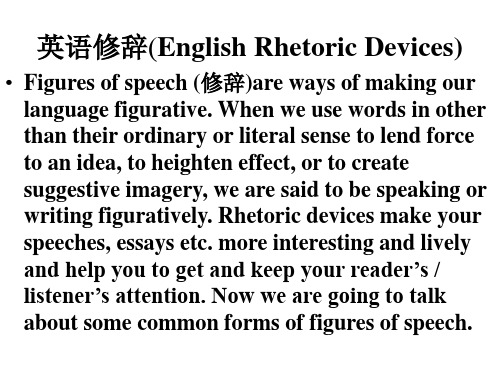English_Rhetorical_英语中常用的修辞手法
英文中最常见的20种修辞手法

• 罗马不是一天建成的,但也不是一年内建成的。(暗指 需要更长时间的努力)
•
• 2. A friend in need is a friend to be avoided.
• 虽然说“患难见真情”,但是一个真的处于患难中的朋 友,是为众人避而远之的。
• • 举个例子
• 1. I am sorry, I am so sorry, I am so extremely sorry. • 真的真的真的很抱歉
•
• 2. Eye had not seen nor ear heard, and nothing had touched his heart of stone.
• 早上不知道几点钟确实是一种好习惯!(反语)
•
• 2."Of course, you only carry large notes, no small change on you. " The waiter said to the beggar.
• 作者对乞丐说,当然,你只收大钞,所以没零钱啦。
• 12、pun 双关 • 双关就是用一个词在句子中的双重含义、借题发挥、作
• 10、allegory 讽喻、比方 • 这是一种源于希腊文的修辞法,意为"换个方式的说法"。
它是一种形象的描述,具有双重性,表层含义与真正意 味的是两回事。
• • 举个例子
• 1. Make the hay while the sun shines. • 良机勿失。(在有太阳的时候晒草--制作饲料的干草)
• 2. The state of this house is cheerless welcome. • 这座房子无精打采地迎接着客人。
rhetorics修辞 英语常用修辞格比较及其解析

Logos\Pathos\Ethos 逻辑\情感\人格
Rhetoric
Broad stylistic context
Narrow stylistic context
Style/type of writing
Stylistic devices figures of speech
1.Definiton
在希腊语,拉丁语、法语、西班牙语及意大利语中, rhetoric 这个次的词根都是“说话”的意思。
Rhetoric: 17世纪末英国哲学家John Locke 曾经 把修辞称做“演说术”(the science of oratory), 是“说话得体、优美和有力的艺术”(speaking with propriety, elegance, and force)
2. Assonance是在一句话或在一个诗行中间,有 两个或更多的词具有相同的元音。与汉语的叠韵 (两个或多个音节彼此韵母相同东风dong fong , )非常相似。如:fair and square/near and dear With this faith we will be able to hew out of the mountain of despair a stone of hope.怀着这个信 念,我们能把绝望的大山凿成希望的磐石。 Whether or not you are busy or lazy, write to me. The rain in Spain stays mainly in the plain.
syntax
哪些是亲昵的表达方式,那哪些是地位高的人对地 位低的人委婉的表达方式, 哪些最有可能带有“贬” 意的色彩? A. Close the door, dear B. Would you be so kind to close the door? C. It is a bit cold here. Can you close the door? D. Would you like to close the door for me? E.I would be glad if you could close the door? F. Would you mind closing the door?
英语语言学之常见修辞English Rhetoric

英语修辞(English Rhetoric)Figures of speech are ways of making our language figurative. When we use words in other than their ordinary or literal sense to lend force to an idea, to heighten effect, or to create suggestive imagery, we are said to be speaking or writing figuratively.1.Simile明喻: An explicit comparison, e.g. The pen is to a writer what the gun is toa soldier.2.Metaphor暗喻: An implicit comparison, e.g. Some books are to be tasted, othersto be swallowed and some few to be chewed.3.Personification拟人: The attribution of animate qualities to inanimate objects, e.g.the wind whistled through the trees.4.Onomatopoeia拟声: the imitation of sounds, e.g. tinkle, clank, bang5.Hyperbole夸张: Overstatement, exaggeration, e.g. A drop of ink may make amillion think.6.Understatement低调陈述: A restrained statement, e.g. He could do better.7.Euphemism委婉语: An inoffensive expression, e.g. the needy, cease to think8.Parallelism排比: Parallel structures, e.g. We shall fight him by land …by sea …in the air.9.Repetition重复: repetition o f the same words, e.g. Don’t trouble trouble until …10.Antithesis对照: Contrast, e.g. Men make houses, women make homes. Pennywise, pound…11.Climax渐进: Progression of thought, e.g. I came, I saw, I conquered.12.Anti-climax突降: Sudden descent of thought, e.g. He lost his empire, his familyand his pen.13.Paradox隽语: A seemingly contradictory statement, e.g. The child is father of theman.14.Oxymoron矛盾修辞: the combination of contradictory terms, e.g. cruel sweetlove15.Transferred epithet 移就: a descriptive term transferred from the appropriatenoun to modify another to which it does not really apply, e.g. sleepless night, expensive tastes, sweet teeth16.Alliteration头韵: Head rhyme, e.g. Practice makes perfect.17.Assonance腹韵: V owel rhyme, e.g. First thrive, then wife.18.Consonance尾韵: End rhyme, e.g. East or west, home is best.19.Rhyme押韵: e.g. Man proposes; god disposes. Well begun is half done. Well fed,well bred.20.Pun双关: Humorous use of homonymy, e.g. Seven days without water make oneweak/week.21.Allusion引喻: an implicit reference to an event/story, e.g. pound of flesh22.Metonymy转喻: The use of the name of one thing for another with which it isclosely associated, e.g. The pen is mightier than the sword. the gray hair, the bottle, the tongue23.Synecdoche提喻: the substitution of the whole for the part, or vice versa, e.g.short of hands,24.Antonomasia换喻: the use of a proper name to stand for sth else having anattribute associated with that name, Judas for a traitor, Solomon for a wise man, Nero for a tyrant25.Irony反语: The expression of actual intent in words that carry the oppositemeaning.sarcasm明讽: a strong form of irony, e.g. Gentlemen like you carry only large notes.innuendo暗讽: a mild form of irony, e.g. In a group they were brave.satire讽刺文学: An ironic literary work1.parody 仿拟: Beauty is more than skin deep. Once choose, always use.2.zeugma 轭式搭配: He gets out of bed and humor.3.syllepsis一语双叙: take the oath and his seats,He lost his temper and his hat.4.palindrome回文: No X in Nixon. Step on no pets. Madam, I’m Adam.5.epigram警句: brief, pointed saying that has the nature of a proverb6.malapropism词语误用: 200 light years ago, brus diver (bus driver), brive a dus 1.Analogy: a comparison in which different items are compared point by point,usually with the idea of explaining something unknown by something known.Analogies are offered to provide insights, and can be very instructive. Dictionaries are like watches; the worst is better than none, and the best cannot be expected to go quite true.2.Symbolism: In writing, symbolism is the use of a word, a phrase, or a description,which represents a deeper meaning than the words themselves.3.Plantification: giving man or things plant-like characters. The sky was like a fadedrose.4.materialization: 美感垂手可得却无法靠前5.Zoosemy: reverse personification, animal or things attributes applied to people.e.g. Children are flowers of our country.6.Apostrophe顿呼: England! Awake! Awake! Awake!7.Rhetorical question修辞问句: The rhetorical question is usually defined as anyquestion asked for a purpose other than to obtain the information the question asks.8.Periodic sentence圆周句: a complex sentence in which the main clause comeslast and is preceded by the subordinate clause (loose sentence松散句)9.anagram变位词: Words or phrases rearranged, William Shakespeare = I swearhe's like a lamp. We all make his praise. Has a peer, I ask me? Ah, I speak a swell rime (rhyme).10.Hypallage移就: synaesthesia通感, empathy移情and transferred epithet转类通感Sweet voice/ icy look/ sharp cry/ sour remark/ oily-tongued移情Lazy clouds drifted across the sky.转类His dry humor doe sn’t seem intentional.修辞格(figures of speech) 大体分为三类:音韵phonological词义semantic句法syntactical。
几种常见的修辞方法英语表达

几种常见的修辞方法英语表达1. 比喻 (Metaphor): 将一个事物与另一个事物进行比较,以便更好地理解。
例如:"Life is a rollercoaster."2. 暗喻 (Metonymy): 用一个相关的词或短语来代替具体的名词,以便引起读者的兴趣。
例如:"The White House decided to take action."3. 象征 (Symbolism): 使用象征性的词语或符号来代表某种意义或主题。
例如:"The dove is a symbol of peace."4. 反问 (Rhetorical question): 提出一个问题,不是为了得到答案,而是为了引起读者的思考。
例如:"Don't we all want to be happy?"5. 对偶 (Paradox): 使用矛盾的词语或观点,以引起读者的注意。
例如:"In order to be free, we must be disciplined."6. 排比 (Parallelism): 使用相似的结构或形式来强调一系列词语或短语。
例如:"I came, I saw, I conquered."7. 反复 (Repetition): 重复一个词语或短语,以增强词语的重要性或强调某种情感。
例如:"Never give up, never surrender."8. 夸张 (Hyperbole): 夸张某个事物的程度或程度,以引起读者的注意。
例如:"I've told you a million times."9. 对称 (Chiasmus): 使用相同的词语或短语,但以相反的顺序进行重复,以增加词语的影响力。
例如:"Fair is foul and foul is fair."以上是几种常见的修辞方法,它们可以帮助写作更具有表现力和魅力,引起读者的兴趣和注意。
《高级英语》复习资料 The Review of Advanced English2

The Review of Advanced English (Book 1)一、修辞(rhetoric)Ⅰ. 修辞手法:1)明喻(simile)是以两种具有相同特征的事物和现象进行对比,表明本体和喻体之间的相似关系,两者都在对比中出现。
常用比喻词like, as, as if, as though等。
2)隐喻(metaphor)这种比喻不用比喻词进行,而直接将甲事物当作乙事物来描写,甲乙两事物之间的联系和相似之处是暗含的。
3)提喻(synecdoche)又称举隅法,主要特点是局部代表全体,或以全体喻指部分,或以抽象代具体,或以具体代抽象。
[用部分代整体,有隶属关系]4)借代(metonymy)是指两种不同事物并不相似,但又密不可分,因而常用其中一种事物名称代替另一种。
[用部分代整体,非隶属关系]5)拟人(personification)这种修辞方法是把人类的特点、特性加于外界事物之上,使之人格化,以物拟人,以达到彼此交融,合二为一。
6)叠言(rhetorical repetition)这种修辞法是指在特定的语境中,将相同的结构,相同意义词组成句子重叠使用,以增强语气和力量。
7)双关语(pun)是以一个词或词组,用巧妙的办法同时把互不关联的两种含义结合起来,以取得一种诙谐有趣的效果。
8)拟声(onomatopoeia)是摹仿自然界中非语言的声音,其发音和所描写的事物的声音很相似,使语言显得生动,富有表现力。
9)讽刺(irony)是指用含蓄的褒义词语来表示其反面的意义,从而达到使本义更加幽默,更加讽刺的效果。
10)通感(synesthesia)是指在某个感官所产生的感觉,转到另一个感官的心理感受。
11)alliteration(头韵):在文句中有两个以上连结在一起的词或词组,其开头的音节有同样的字母或声音,以增强语言的节奏感。
assonance(腹韵):相同或相近的元音在诗行中重复出现;consonance(假韵):两个以上词的词尾辅音完全一致,但其前面的元音不相同;the end rhyme(尾韵):诗行与诗行之间在末尾的压韵/ 尾韵/脚韵12)anadiplosis(联珠):将一个或一组单词重复多遍;anticlimax(突降法):也叫先扬后抑。
英语修辞方法28(上课用)

Rhetorical Devices in English1. 明喻simile英语的明喻是英语中最常用、最简便的修辞格之一,在文学作品中尤其如此。
它根据人们的联想,利用不同事物之间的相似点,借助比喻词(如like,as等)起连接作用,清楚地说明甲事物在某方面像乙事物。
Rhetoric In Practice (《英文实用修辞学》)一书这样来解释明喻:“A simile is an expressed 1ikeness.The simplest and most direct way of connoting an idea with something else is by means of using similes.Simile is the neuter singular of the Latin adjective‘similis,’meaning like.”1. 关于英语Simile,有两点须加以说明:一、Simile(明喻)通常由三部分构成,即本体(tenor或subject)、喻体(vehicle或reference)和比喻词(comparative word或indicator of resemblance)。
可图示如下:Marriage is like a beleaguered fortress: those who are without want to get in,↓↓↓(tenor) (comparative word) (vehicle) and those within want to get out. ( P. M. Quitard)二、本体与喻体一般为两个不同事物(如属同类也应具不同性质或特征),比喻方可成立。
例如:①Peter is as tall as his father.②Peter is as tall as a Maypole.稍加分析可以看出,例①不算明喻,只是一个比较句,因为Peter及其father同属人类;而例②才是比喻句,因为Peter与Maypole分属人与物。
English_Rhetoric_Devices_英语常用修辞手法

Simile:(明喻)
It is an expressed likeness, which makes a comparison between two unlike elements having at least one quality or characteristic (特性)in common. To make the comparison, words like as, as...as, as if and like are used to transfer the quality we associate with one to the other. • e.g As cold water is to a thirsty soul, so is good news from a far country. • Reason is to faith as the eye to the telescope. • He bellowed like a bull seeking combat.
Synecdoche (提喻)
• Synechdoche is some kind of generalization or specification that involves the substitution of the part for the whole, or the whole for the part. 用局部代替整体,单个代替类别,具体代替抽 象;或反过来。 • They say there’s bread and work for all. • Turning our long boat round […] on the last morning required all hands on deck … (hands = people) • Troops halt the drivers (troops = soldiers) • She wore gold around her neck. (gold = chain)ike a simile, also makes a comparison between two unlike elements, but unlike a simile, this comparison is implied rather than stated. • e.g The world is a stage. • The fountain of knowledge will dry up unless it is continuously replenished by streams of new learning.
英语修辞手法介绍

英语修辞手法介绍文章摘要:本文介绍了英语中常用的12种修辞手法,包括它们的定义、功能、标志词和例句。
修辞手法是一种运用语言的艺术,可以使语言更生动、有力、有趣和有说服力。
通过学习和掌握这些修辞手法,可以提高英语写作和阅读的水平,增加文学欣赏的乐趣,也可以培养创造性思维和表达能力。
1. 演绎推理 (Deductive Reasoning)1.1 定义演绎推理,也称为自上而下的逻辑,是一种修辞手法,也是建立成功论点的一种方式。
演绎推理是从一个或多个一般原则或前提出发,推导出一个具体的结论或结果。
演绎推理的有效性取决于前提的真实性和逻辑的正确性。
1.2 功能演绎推理的功能是:使论点更有说服力和权威性使论点更清晰和条理化使论点更容易被理解和接受使论点更具有逻辑性和一致性1.3 标志词演绎推理的标志词有:therefore 因此thus 如此hence 所以consequently 结果as a result 结果if...then 如果...那么since 既然for 因为1.4 例句All men are mortal. Socrates is a man. Therefore, Socrates is mortal. 所有人都会死。
苏格拉底是人。
因此,苏格拉底会死。
If you study hard, then you will pass the exam. 如果你努力学习,那么你就会通过考试。
Since it is raining, you should take an umbrella. 既然下雨了,你应该带把伞。
2. 模糊语 (Ambiguity)2.1 定义模糊语包含多个含义的单词、短语或陈述。
模糊语有时会导致含糊不清和混乱,有时会有无意的幽默出现。
模糊语可以分为以下几种类型:词汇模糊:一个单词有多个含义,例如bank(银行或河岸)结构模糊:一个句子有多种解读方式,例如I saw her duck(我看见她躲避或我看见她的鸭子)参考模糊:一个代词指代不明确,例如He said that he loves him(他说他爱他)指示模糊:一个指示词指示不明确,例如This is good(这个很好)2.2 功能模糊语的功能是:增加语言的多样性和灵活性创造幽默和讽刺的效果避免直接表达敏感或不礼貌的内容表达隐晦或暗示的意思引起读者或听者的注意和思考2.3 标志词模糊语没有特定的标志词,但可以通过以下方法来识别:分析单词、句子、代词或指示词是否有多种可能的含义分析上下文是否提供了足够的信息来消除歧义分析作者或说话者是否故意使用模糊语来达到某种目的2.4 例句I went to the bank. 我去了银行(或河岸)。
- 1、下载文档前请自行甄别文档内容的完整性,平台不提供额外的编辑、内容补充、找答案等附加服务。
- 2、"仅部分预览"的文档,不可在线预览部分如存在完整性等问题,可反馈申请退款(可完整预览的文档不适用该条件!)。
- 3、如文档侵犯您的权益,请联系客服反馈,我们会尽快为您处理(人工客服工作时间:9:00-18:30)。
语料驱动的微观修辞操作与英语写作教学研究English Rhetorical Devices英语中的修辞与汉语的修辞相比,分类细,种类多。
下面将英语中的修辞(部分)简单介绍如下:1. Simile 明喻.【英释】It is a figure of speech which makes a comparison between two unlike elements having at least one quality or characteristic in common. To make the comparison, words like as, as...as, as if and like are used to transfer the quality we associate with one to the other.【汉释】明喻是一种表现一事物像另一事物的修辞格。
说得通俗点,也就是打比方,即把要描述的事物——本体(A)用比喻词与另一种具有鲜明的同一特征的事物——喻体(B)联系起来。
常用的比喻词有as(如),like(像),seem(似乎),as if(好像),as through(好像),such as(像……一样)等。
其基本格式是“A is like B”或“A is as……as B”。
【例句】①He was like a cock who thought the sun had risen to hear him crow.②I wandered lonely as a cloud.③Einstein only had a blanket on, as if he had just walked out of a fairy tale.④My heart is like a singing bird.⑤O my love's like a red, red rose.2. Metaphor 暗喻,隐喻.【英释】It is like a simile, also makes a comparison between two unlike elements, but unlike a simile, this comparison is implied rather than stated.【汉释】暗喻是本体和喻体同时出现,它们之间在形式上是相合的关系,说甲(本体)是(喻词)乙(喻体)。
喻词常由:是、就是、成了、成为、变成等表判断的词语来充当,不用like 或as等表示出来,而是进行隐藏的比较。
暗喻又叫隐喻。
【例句】①Hope is a good breakfast, but it is a bad supper.②Some books are to be tasted, others swallowed, and some few to be chewed and digested.③She is a woman with a stony heart.④Mark Twain is a mirror of America.⑤He is a pig.3. Metonymy 转喻,借喻.【英释】It is a figure of speech that has to do with the substitution of the mane of one thing for that of another.【汉释】转喻是指当甲事物同乙事物不相类似,但有密切关系时,可以利用这种关系,以乙事物的名称来取代甲事物,这样的一种修辞手段;或者说是一种一个词或词组被另一个与之有紧密联系的词或词组替换的修辞方法。
转喻的重点不是在“相似”;而是在“联想”。
转喻又称借喻、换喻,或借代。
【例句】①The kettle boils.水开了(用the kettle壶,表示the water in the kettle 壶里的水)。
②The room sat silent.全屋人安静地坐着(用the room房间,表示the people in the room房间里的人)。
③Grey hairs should be respected.老人应受到尊重(用grey hairs白发,表示old people老人)。
④The pen is mightier than the sword.笔要比剑更锋利(用pen笔,表示article文章)。
⑤I am reading Lu Hsun.我在读鲁迅的作品(用Lu Hsun鲁迅,表示Lu Hsun's works鲁迅的作品)。
4. Synecdoche 提喻.【英释】It is involves the substitution of the part for the whole, or the whole for the part,etc.【汉释】提喻是用部分代替全(整)体,或用全(整)体代替部分,或特殊代替一般。
【例句】①There are about 100 hands working in his factory.[部分代替整体]他的厂里约有100名工人。
②It was reported that China won the volleyball match.[整体代替部分]椐报载:在这次排球赛中,中国队赢了。
③He is the Newton of this century.[特殊代替一般]他是本世纪的牛顿.5. Allegory 讽喻,寓言.【英释】An expressive style that uses fictional characters and events to describe some subject by suggestive resemblances; an extended metaphor.【汉释】建立在假借过去或别处的事例与对象之上(或以讲故事、寓言的形式),传达暗示,影射或者讥讽现世各种现象的含义;意为“换个方式的说法”。
它是一种形象的描述,具有双重性,表层含义与真正意味的是两回事。
【例句】①Make the hay while the sun shines.表层含义:趁着出太阳的时候晒草。
真正意味:趁热打铁。
②It's time to turn plough into sword.表层含义:是时候把犁变成剑。
真正意味:时机成熟了。
6. Personification 拟人.【英释】It gives human form of feelings to animals, or life and personal attributes to(赋予) inanimate(无生命的) objects, or to ideas and abstractions(抽象的事物).【汉释】拟人是指把物(包括物体、动物、思想或抽象概念等)拟作人,使其具有人的外表、个性或情感的一种修辞手段。
拟人可以通过形容词、动词、名词等表现出来。
【例句】①The night gently lays her hand at our fevered heads. [把夜拟人化]②I was very happy and could hear the birds singing in the woods. [把鸟拟人化]③Did you see the anger of the tempest? 你看到暴风雨的愤怒了吗?④Thirsty soil drank in the rain. 饥渴的土壤在雨中畅饮。
⑤The year 1871 witnessed the heroic uprising of the Paris Commune. 1871年目睹了(爆发了)英勇的巴黎公社起义。
7. Parody 仿拟,模仿.【英释】Parody is a figure of speech involving the imitation of some famous writer or parts of certain well-known works, or the existing idioms to express a kind of new idea.【汉释】仿拟是英语语言学分支修辞学的重要修辞手法之一。
这是一种巧妙、机智、而有趣的修辞格。
它有意仿照人们熟知的现成的语言材料,根据表达的需要临时创造出(改变成)新的语、句、篇来,以使语言生动活泼,或讽刺嘲弄,或幽默诙谐,妙趣昂然。
在运用时所仿拟的一般是人们所熟知的语言材料,如成语、谚语、明言、警句等。
【例句】①Rome was not built in a day, nor in a year.②A friend in need is a friend to be avoided.③If you give a girl an inch nowadays she will make address of it.④Where there is a will, there is a lawsuit. 有遗嘱必有官司。
⑤To Lie or Not To Lie,that is a question. [Shakespeare: To be or not to be,that is a question.]8. Parallelism 排比,平行.【英释】Similarity of structure in a pair or series of related words, phrases, clauses,sen- Tence,part,etc.【汉释】排比是把两个或两个以上的结构大体相同或相似,意思相关,语气一致的短语、句子等排列成串,形成一个整体,用来加强语势强调内容、加重感情的修辞方式。
【例句】①No one can be perfectly free till all are free; no one can be perfectly moral till all are moral; no one can be perfectly happy till all are happy.②In the days when all these things are to be answered for, I summon you and yours, to the last of your bad race, to answer for them. In the days when all these things are to be answered for, I summon your brother, the worst of your bad race, to answer for them separately.③Perch are inexpensive; cod are cheap; trout are abundant; but salmon are best.9. Antithesis 对偶,对照,对比.【英释】It is the deliberate arrangement of contrasting words or ideas in balanced structural forms to achieve emphasis.【汉释】用两个结构相似、意义相近或相反的词组或句子来表达相关、相近或相反意思的一种修辞方式叫对偶。
